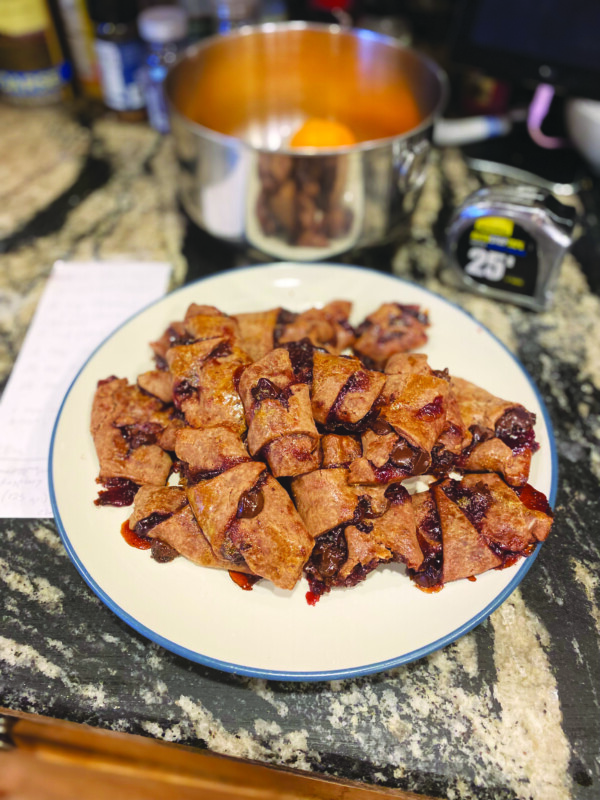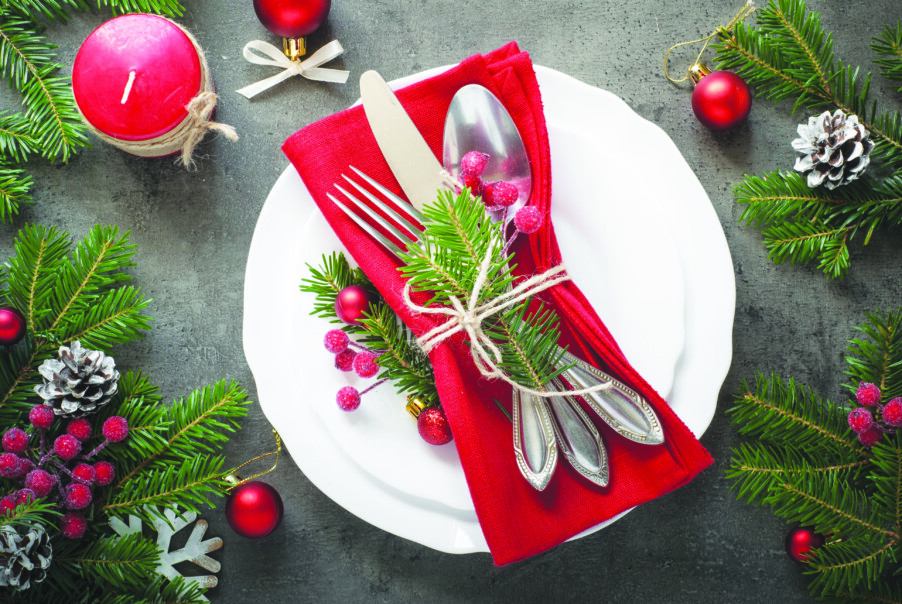Where to find holiday meals & meals on a holiday
Here are a few of the places offering special holiday meals and that are open on Tuesday, Dec. 24. Know of another Feast of Seven Fishes or kitchen serving up meals on Christmas Eve or Christmas Day? Let us know at [email protected] for inclusion in next week’s Weekly Dish.
Before Dec. 24
• Colby Hill Inn (33 The Oaks in Henniker, colbyhillinn.com) will hold a Christmas High Tea on Saturday, Dec. 14, and Sunday, Dec. 15, at 12:30 p.m. featuring teas and other beverages; salads and savories, such as mini beef Wellington, mini cucumber sandwiches and more, and sweets such as gingerbread scones, stollen, Christmas cookies and more.
• The Artisan Hotel at Tuscan Village (17 Via Toscana, Salem, tuscanbrands.com) will hold a Brunch with Santa on Sunday, Dec. 15, from 11:30 a.m. to 1 p.m. The food offerings include omelet and prime rib stations; a buffet with salads, breakfast items, vegetables, pan-seared chicken, baked haddock and meatballs; sweets including chocolate fondue and croquembouche, and beverages. The cost is $90 per person.
• The Artisan Hotel at Tuscan Village (17 Via Toscana, Salem, tuscanbrands.com ) will hold a Holiday Special Frank Sinatra Dinner with the Strictly Sinatra Band on Sunday, Dec. 15. Dinner featuring a five-course Italian-inspired meal is at 5 p.m., showtime at 6:30 p.m. Tickets cost $198.
• Bedford Village Inn (2 Olde Bedford Way, Bedford, 472-2001, bedfordvillageinn.com) will host a Feast of the Seven Fishes on Monday, Dec. 23, from 6 to 9 p.m. This traditional Italian celebration will feature a five-course plated seafood dinner with wine pairings. The cost for this 21+ event is $125 per person.
• Greenleaf(54 Nashua St., Milford, 213-5447, greenleafmilford.com) will host a Feast of Seven Fishes, Thursday, Dec. 19, beginning at 5:30 p.m., featuring six seafood courses as well as dessert. The cost is $145 per person, through Greenleaf’s website.
Christmas Eve
• Airport Diner (2280 Brown Ave., Manchester, 623-5040, thecman.com) is open from 6 a.m. to 3 p.m.
• Alan’s Restaurant (133 N. Main St., Boscawen, 753-6631, alansofboscawen. com) is open 11 a.m. to 5 p.m.
Angela’s Pasta, Cheese and Wine (815 Chestnut St., Manchester, 625-9544, angelaspastaandcheese.com) will close at 4 p.m. on Christmas Eve.
Bedford Village Inn (2 Olde Bedford Way, Bedford, 472-2001, bedfordvillageinn.com) will also offer a three-course prix fixe menu on Christmas Eve, Tuesday, Dec. 24, from 4:30 to 8:30 p.m., followed by a Grand Dessert Buffet and cash bar in the Great Hall. It will cost $125 per adult, or $75 for each child 12 and under.
• Buckley’s Great Steaks (438 DW Highway, Merrimack, 424-0995, buckleysgreasteaks.com) is taking reservations for Christmas Eve.
• Chez Vachon (136 Kelley St., Manchester, 625-9660, chezvachon.com) will be open normal business hours on Christmas Eve — 7 a.m. to 2 p.m.
• CR’s The Restaurant (287 Exeter Road, Hampton, 929-7972, crstherestaurant.com) will be open from 4:30 to 8:30 p.m.
• The Derryfield Restaurant (625 Mammoth Road, Manchester, 623-2880, thederryfield.com) will be open from 11 a.m. to 6:30 p.m.
• The Farm Bar & Grille (1181 Elm St, Manchester, 641-3276, farmbargrille.com) will be open during regular business hours, noon to 11 p.m.
• Chen Yang Li (124 S. River Road, Bedford, 641-6922, chenyangli.com) is open from 11:30 a.m. to 9 p.m. on Tuesdays and Wednesdays and will offer a special menu on Christmas Eve and Christmas Day — see the website.
• Chen Yang Li (379 Amherst St, Nashua, 578-9888, chenyanglinh.com) will be open 11:30 a.m. to 9:30 p.m.
• Chen Yang Li (520 South St, Bow, 228-8508, chenyangli-bow.com) will be open Dec.24, from 11 a.m. to 10 p.m., and Wednesday, Dec.25, from 12 to 10 p.m
• The Common Man restaurants in Concord (1 Gulf St., 228-3463) and Merrimack (304 DW Highway, 429-3463) are open from 11:30 to 3 p.m. Windham (88 Range Road) is open for gift card sales only from 11 a.m. to 3 p.m. See thecman.com.
• Copper Door (15 Leavy Drive, Bedford, 488-2677; 41 S. Broadway, Salem, 458-2033, copperdoor.com) is accepting reservations at its restaurants until 8 p.m. and will be open until 10 p.m.
• Epoch Gastropub (90 Front St., Exeter, 778-3762, epochrestaurant.com) will offer a special price-fixed menu, $70 per person, featuring starters, a main course and a dessert plus an intermezzo from 4 to 8 p.m.
• Flying Goose Brew Pub & Grille (40 Andover Road, New London, 526-6899, flyinggoose.com) will be open from 11:30 a.m. until 4 p.m.
• Foster’s Boiler Room (231 Main St., Plymouth, 536-2764, thecman.com) is open from 4 to 8 p.m.
• Fratello’s Italian Grille (155 Dow St, Manchester, 624-2022, fratellos.com) will be open from 11:30 a.m. to 8 p.m.
• Friendly Red’s Tavern (22 Haverhill Road, Route 111, Windham, 437-7251; 111 W Broadway, Derry, 404-6606, friendlyredstavern.net) is open until 8 p.m.
• Gauchos Churrascaria Brazilian Steakhouse (62 Lowell St., Manchester, 669-9460, auchosbraziliansteakhouse.com) will be open Christmas Eve at 4 p.m. with a final seating at 8 p.m. and on Christmas Day for brunch from 10 a.m. to 2 p.m.
• Giorgio’s (707 Milford Road, Merrimack, 883-7333; 524 Nashua St., Milford, 673-3939; 270 Granite St., Manchester, 232-3323, giorgios.com) will be open from noon to 3 p.m. for dining and from 11:30 a.m. to 4 p.m. for pickup of pre-ordered (by Dec. 22) meals. See the website for details.
• La Caretta Mexican Restaurant (lacarretamex.com) will be open in the following locations on Christmas Eve, from 11 a.m. to 7 p.m.: Manchester (1875 S Willow St, Manchester, 623-7705), Manchester (Livingston Park, North End Shops at, 545 Hooksett Road, Manchester, 628-6899), and Portsmouth (172 Hanover St, Portsmouth, 427-8319). The Nashua location (139 DW Highway, Nashua, 891-0055) will be open from 11 a.m. to 3 p.m.. The Derry and Londonderry locations will be closed on Dec.24.
• Lakehouse Grille (281 DW Highway, Meredith, 279-5221, thecman.com/lakehouse-grille) is open from 11:30 a.m. to 8 p.m.
• The Lucky Moose Casino & Tavern (16 Gusabel Ave., Nashua, 864-0175, luckymoosecasino.com) kitche is open until midnight on Dec. 24 and until 10 p.m. on Dec. 25.
• Mr. Mac’s Macaroni and Cheese (497 Hooksett Road, Manchester, 606-1760, mr-macs.com) will be open from 11 a.m. to 4 p.m. on Christmas Eve.
• 900 Degrees (50 Dow St., Manchester, 641-0900, 900degrees.com) will be open from 11:30 a.m. to 5 p.m.
• Puerto Vallarta Mexican Grill (865 Second St, Manchester, 935-9182) and Nuevo Vallarta Mexican Restaurant (791 Second St, Manchester, 782-8762; vallartamexicannh.com) will be open from 11 a.m. to 6 p.m. on Christmas Eve.
• Red Arrow Diner locations (112 Loudon Road, Concord, 415-0444; 137 Rockingham Road, Londonderry, 552-3091; 61 Lowell St., Manchester, 626-1118; 149 DW Highway, Nashua, 204- 5088, redarrowdiner.com) are open 24 hours including on Christmas Eve and Christmas Day.
• Red Blazer (72 Manchester St., Concord, 224-4101, theredblazer.com) will be open 11 a.m. to 4 p.m., when you can also pick up pre-ordered meals to go for Christmas.
• Second Brook Bar & Grill (1100 Hooksett Road, Hooksett, 935-7456, secondbrook.com) will be open in the restaurant until 4 p.m. and at the bar until 5 p.m.
• Shorty’s (1050 Bicentennial Drive, Mancehster; 48 Gusabel Ave., Nashua; shortysmex.com) locations will be open 11:30 a.m. to 5:30 p.m.
• Surf (207 Main St., Nashua, 595-9293, surfseafood.com/nashua) will be open on Tuesday, Dec. 24, at both its Nashua and Portsmouth (99 Bow St.) locations.
• T-Bones (25 S. River Road, Bedford, 641-6100; 404 Main St., Concord; 39 Crystal Ave., Derry, 434-3200; 77 Lowell Road, Hudson, 882-6677; 1182 Union Ave., Laconia; 311 S Broadway, Salem, greatnhrestaurants.com) closes at 5 p.m.
• Tilt’n Diner (61 Laconia Road, Tilton, thecman.com) is open from 6 a.m. to 3 p.m.








